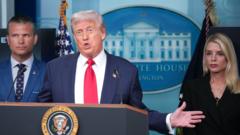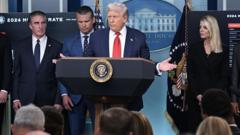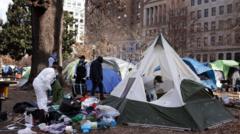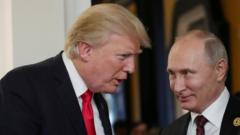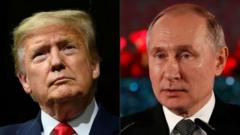Former President Trump's assertions regarding escalating crime in Washington DC are met with a contrasting narrative from Mayor Muriel Bowser, highlighting a reported decrease in violent offenses. While data suggests a downward trend in crime, both the MPDC and FBI statistics differ in magnitude. This article examines the facts behind the conflicting claims on violent crime, homicide rates, and carjacking incidents in the capital.**
Is Crime Declining in Washington DC? An Analysis of Recent Figures and Claims**

Is Crime Declining in Washington DC? An Analysis of Recent Figures and Claims**
Amidst claims of a crime crisis in Washington DC by former President Trump, mayor Muriel Bowser argues that violent crime is on a significant decline. A closer look reveals intriguing data discrepancies and trends.**
Former President Donald Trump recently characterized crime in Washington DC as being "out of control," pledging to deploy National Guard troops to address the allegations of rising violence. At a press conference, he proclaimed a "Liberation Day" for the city, vowing to rectify its crime issues. This proclamation came just as Washington DC Mayor Muriel Bowser countered that crime has significantly decreased and that the city is experiencing its lowest rate of violent crime in three decades.
Trump's declaration of a "crime emergency in the District" was justified by his claims of rising violence; however, data from the Metropolitan Police Department of Washington DC (MPDC) indicates a notable decline in violent crimes, particularly from a peak in 2023. Early reports suggest violent crime has declined by 26 percent this year compared to the same time last year, with an overall drop in robbery incidents recorded at 28 percent.
Despite assertions from both Trump and the DC Police Union regarding the accuracy of the city's crime statistics, discrepancies appear between local and federal reporting. While the MPDC data indicates a 35 percent reduction in violent crime for 2024, the FBI reported a smaller, 9 percent drop. Adam Gelb, CEO of the Council on Criminal Justice (CCJ), remarked that the data, although varied, indicates a significant downward trend in violence since the summer of 2023.
Trump’s claims extended to homicide rates, where he stated that 2023 witnessed the highest rate ever in Washington DC. The FBI reported that the homicide rate surged to around 40 per 100,000 residents—significantly higher than in recent years but still below peak levels from the 1990s. Nevertheless, data from the MPDC show a 12 percent reduction in homicides this year compared to 2024, suggesting a downward trajectory.
In a related context, Trump referenced concerns over carjackings, claiming incidents had more than tripled in the last five years. However, MPDC's records reflect a decline, with 189 carjackings reported this year, down from 300 last year. The CCJ noted that the sharp increase was primarily observed from 2020 onwards. A curfew targeting younger individuals has recently been implemented to combat juvenile crime, particularly in summer months when crime tends to surge.
Comparatively, the analysis by the CCJ indicates that while Washington DC's levels of violence remain higher than the average of several major US cities, the overall declining trend mirrors similar patterns across the nation. An examination of homicide statistics from January to June 2025 showed a 19 percent decline in DC compared to the same period in 2024, slightly exceeding the 17 percent decrease found in the wider sample of cities assessed by the CCJ. However, when compared to pre-COVID figures from 2019, only a 3 percent decline in homicides was observed in the capital, while the same cities reported a 14 percent drop overall.
As the debate continues and calls for investigation into crime levels persist, the conflicting narratives between the Trump administration's portrayal of crime and the local government’s assertion of declining statistics provoke further scrutiny of the capital's safety.




